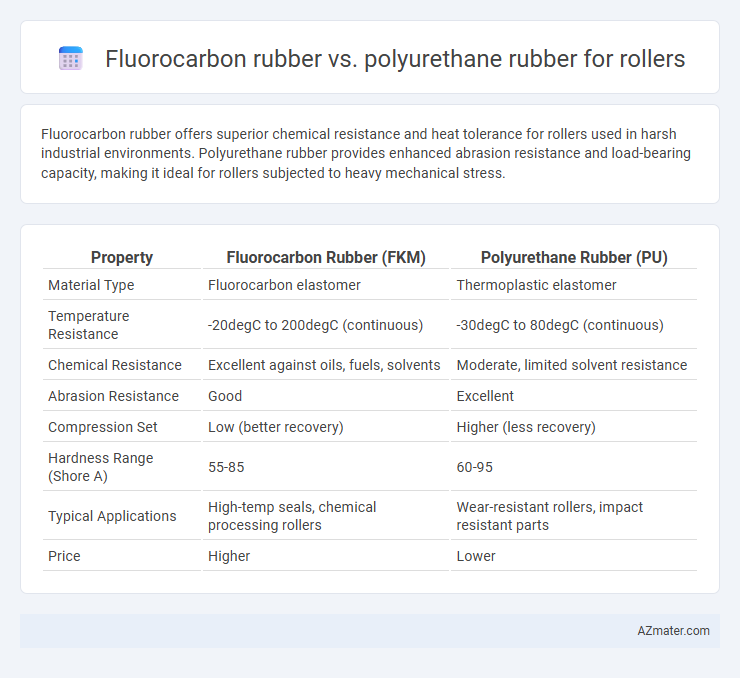Fluorocarbon rubber offers superior chemical resistance and heat tolerance for rollers used in harsh industrial environments. Polyurethane rubber provides enhanced abrasion resistance and load-bearing capacity, making it ideal for rollers subjected to heavy mechanical stress.
Table of Comparison
| Property | Fluorocarbon Rubber (FKM) | Polyurethane Rubber (PU) |
|---|---|---|
| Material Type | Fluorocarbon elastomer | Thermoplastic elastomer |
| Temperature Resistance | -20degC to 200degC (continuous) | -30degC to 80degC (continuous) |
| Chemical Resistance | Excellent against oils, fuels, solvents | Moderate, limited solvent resistance |
| Abrasion Resistance | Good | Excellent |
| Compression Set | Low (better recovery) | Higher (less recovery) |
| Hardness Range (Shore A) | 55-85 | 60-95 |
| Typical Applications | High-temp seals, chemical processing rollers | Wear-resistant rollers, impact resistant parts |
| Price | Higher | Lower |
Introduction to Roller Materials
Fluorocarbon rubber offers exceptional chemical resistance, high-temperature stability, and excellent abrasion resistance, making it ideal for rollers used in harsh industrial environments. Polyurethane rubber provides superior toughness, elasticity, and load-bearing capacity, ensuring durability and efficient performance in heavy-duty roller applications. Selecting the right roller material depends on the specific operational requirements, including exposure to chemicals, temperature ranges, and mechanical stress.
Overview of Fluorocarbon Rubber
Fluorocarbon rubber (FKM) offers exceptional chemical resistance, high-temperature tolerance up to 250degC, and superior durability in harsh environments, making it ideal for rollers exposed to oils, fuels, and aggressive chemicals. Its low permeability and excellent resistance to ozone and weathering extend the lifespan of rollers in demanding industrial applications. Compared to polyurethane rubber, fluorocarbon rubber provides enhanced performance in extreme chemical and thermal conditions but may have lower abrasion resistance.
Overview of Polyurethane Rubber
Polyurethane rubber is renowned for its exceptional abrasion resistance, high tensile strength, and excellent elasticity, making it ideal for roller applications subjected to heavy wear and impact. Its superior mechanical properties outperform many elastomers, including fluorocarbon rubber, especially in environments requiring resilience against tearing and deformation. Polyurethane rollers also offer enhanced load-bearing capacity and resistance to oils, greases, and solvents, contributing to extended operational life in industrial machinery.
Key Mechanical Properties Comparison
Fluorocarbon rubber exhibits superior chemical resistance, heat stability up to 200degC, and excellent abrasion resistance, making it ideal for harsh environments and high-temperature applications. Polyurethane rubber offers outstanding tensile strength, elasticity, and superior abrasion resistance, with operating temperatures typically ranging from -40degC to 80degC, providing durability under mechanical stress. The choice between fluorocarbon and polyurethane rubber for rollers depends on specific mechanical property requirements such as temperature tolerance, chemical exposure, and wear resistance for optimal performance.
Chemical Resistance: Fluorocarbon vs Polyurethane
Fluorocarbon rubber offers superior chemical resistance compared to polyurethane rubber, excelling in harsh environments with exposure to acids, oils, and solvents. Polyurethane rubber is less resistant to aggressive chemicals but provides better abrasion resistance and mechanical strength. For rollers operating in chemically aggressive conditions, fluorocarbon rubber is the preferred material due to its ability to maintain integrity and performance under prolonged chemical exposure.
Temperature Tolerance and Performance
Fluorocarbon rubber (FKM) exhibits exceptional temperature tolerance, maintaining stability and flexibility in continuous use up to 200-250degC, making it ideal for high-heat roller applications. Polyurethane rubber typically withstands temperatures up to 80-90degC but offers superior abrasion resistance and load-bearing capacity, enhancing roller durability under mechanical stress. Selection between fluorocarbon and polyurethane rubber depends on operational temperature requirements and performance needs, with FKM favored for high-temperature environments and polyurethane preferred for heavy-duty wear resistance.
Wear and Abrasion Resistance
Fluorocarbon rubber exhibits superior wear and abrasion resistance compared to polyurethane rubber, making it ideal for roller applications exposed to harsh chemicals and high temperatures. Polyurethane rubber offers excellent abrasion resistance but tends to degrade faster under extreme thermal and chemical conditions. Fluorocarbon's molecular stability and resistance to swelling maintain roller integrity and performance in demanding environments.
Cost and Availability
Fluorocarbon rubber, known for its superior chemical resistance and high-temperature tolerance, generally comes at a higher cost due to its complex manufacturing process and limited raw material availability. Polyurethane rubber offers a more cost-effective solution with greater availability, making it a preferred choice for rollers in applications requiring abrasion resistance and flexibility. The price difference between fluorocarbon and polyurethane rubbers significantly impacts budget decisions, especially when large quantities or replacement parts are needed quickly.
Application Suitability in Industrial Rollers
Fluorocarbon rubber offers exceptional chemical resistance and high-temperature stability, making it ideal for industrial rollers in harsh environments such as chemical processing and oil refining. Polyurethane rubber provides superior abrasion resistance and load-bearing capacity, which suits rollers used in heavy-duty material handling and printing industries. Selecting the appropriate roller material depends on the specific industrial application's exposure to chemicals, temperature, and mechanical wear.
Conclusion: Choosing the Right Rubber for Rollers
Fluorocarbon rubber offers superior chemical resistance, heat stability up to 200degC, and excellent abrasion resistance, making it ideal for harsh industrial environments involving oils, fuels, and solvents. Polyurethane rubber provides exceptional mechanical strength, high tear resistance, and good flexibility, suited for heavy-load rollers requiring durability and impact absorption. Selecting the right rubber for rollers depends on specific application demands: opt for fluorocarbon rubber in chemically aggressive or high-temperature settings, while polyurethane excels in applications needing toughness and longevity under mechanical stress.

Infographic: Fluorocarbon rubber vs Polyurethane rubber for Roller
 azmater.com
azmater.com